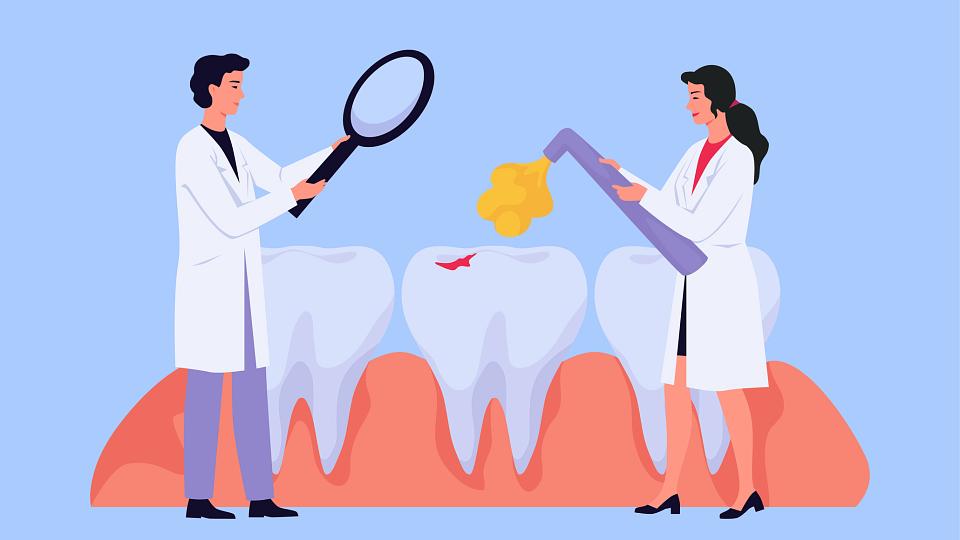
Getting to the Pain Behind Root Canals
Most people have heard the term “root canal” or have even had the procedure but are unsure of exactly what root canal treatment is.
“I have heard many patients say a root canal is when a dentist removes the root of their tooth,” says Danielle Wingrove, DDS, section head of endodontics at the University of Utah School of Dentistry.
Root canal treatment does not remove the root of the tooth but rather the pulp inside the root. Let’s back up a few steps and understand a bit about the anatomy of the tooth before getting into the procedure of root canal treatment.
The Inner Workings of a Tooth
The tooth consists of the crown, which is seen when you open your mouth, and the root, which is contained in the jawbone. The crown of the tooth consists of three layers: the outer layer is the enamel, the second layer is called dentin, and the third layer is the pulp. The root has similar layers, except there is no enamel but a different hard tissue substance called cementum.

The pulp is the same in the crown and the root of the tooth. The pulp consists of nerves, blood vessels, and connective tissue. The pulp is very important throughout the life of the tooth, but especially during tooth development. The pulp provides nutrients and signals to cells within the pulp to produce the dentin of the tooth. This dentin provides the structural foundation of the tooth. The nerves within the pulp provide sensation within the tooth such as thermal sensitivity and location/movement. These nerves can become inflamed due to damage of the tooth from dental caries (the clinical term for cavities), cracks, and trauma.
When these nerves become inflamed, they send signals to the brain, which is interpreted as pain. This pain may be very intense and can be sustained throughout the day.
“It is this pain that gives root canals such a bad name,” Wingrove says. “The root canal procedure helps patients get out of pain, but what the patient remembers is the pain prior to the root canal. This pain can also make it tougher to achieve profound anesthesia if a provider is not accustomed to dealing with this type of pain.”
When you need a root canal
Root canal treatment is often used by people to compare with some of the worst things that can happen to a person. “I tell patients that people only tell the stories of a painful root canal because a painless root canal is not a good story,” Wingrove says. “You rarely hear a patient tell a friend about this wonderful root canal they just had.” However, root canal treatment does not have to be painful and should be virtually painless if done correctly.
The process of a root canal involves:
- Removing the pulp tissue from the crown and root of the tooth
The first step starts with profound anesthesia of the pulp tissue. The dentist will then drill a hole on the biting surface of the tooth and access the pulp tissue. Then the dentist will use very small instruments to remove the tissue, as well as a small amount of the dentin within the canal space, to help remove any bacteria inside the canal.
- Disinfecting the inside of the canal space
After removing the pulp tissue, a rubber dam is placed to protect the patient’s airway as well as maintain a clean area around the tooth and not let saliva contaminate the canal space.
- Filling the space with an inert material to seal it off
Once the tooth has been sufficiently cleaned and shaped, it is then filled with an inert material called gutta percha. Along with the gutta percha, a sealer is placed into the canal.
Recent advancements in calcium silicate cements have made their use as a sealer possible. Calcium silicate cements are very biocompatible, provide excellent sealing ability, and do not degrade over time.
“The field of endodontics is very exciting,” Wingrove says. “New advances are coming all the time as we learn more and more about the pulp tissue and even its ability to heal. It was long thought that once the pulp was inflamed, it had to be removed. There is a lot of research happening on this concept and the possibility it can heal without needing root canal treatment.”
Prevention is key
Most root canal treatments can be avoided and prevented. The majority of root canal treatments are due to dental caries (cavities), which can be prevented with good oral hygiene, a diet low in sugar and simple carbohydrates, and by visiting your dentist for those biannual cleanings and check-ups.
“I always tell my patients that if I could prevent all root canal treatments and be put out of a job, I’d be a happy camper,” Wingrove says. “Not that I don’t love to perform root canal treatment, but it is such a preventable procedure that I’d love to see people take care of their teeth and never need my services.”
How to Access Affordable Dental Care
Dental health is crucial, but not always affordable for all budgets. James Bekker, DMD, from University of Utah School of Dentistry, offers an insider's guide to finding and utilizing low-cost dental services.
Understanding Tooth Sensitivity and How to Manage It
Feeling discomfort when eating hot or cold foods? Tooth sensitivity can be more than just a minor annoyance—it could signal a deeper issue. David Okano, MD, breaks down what different...






